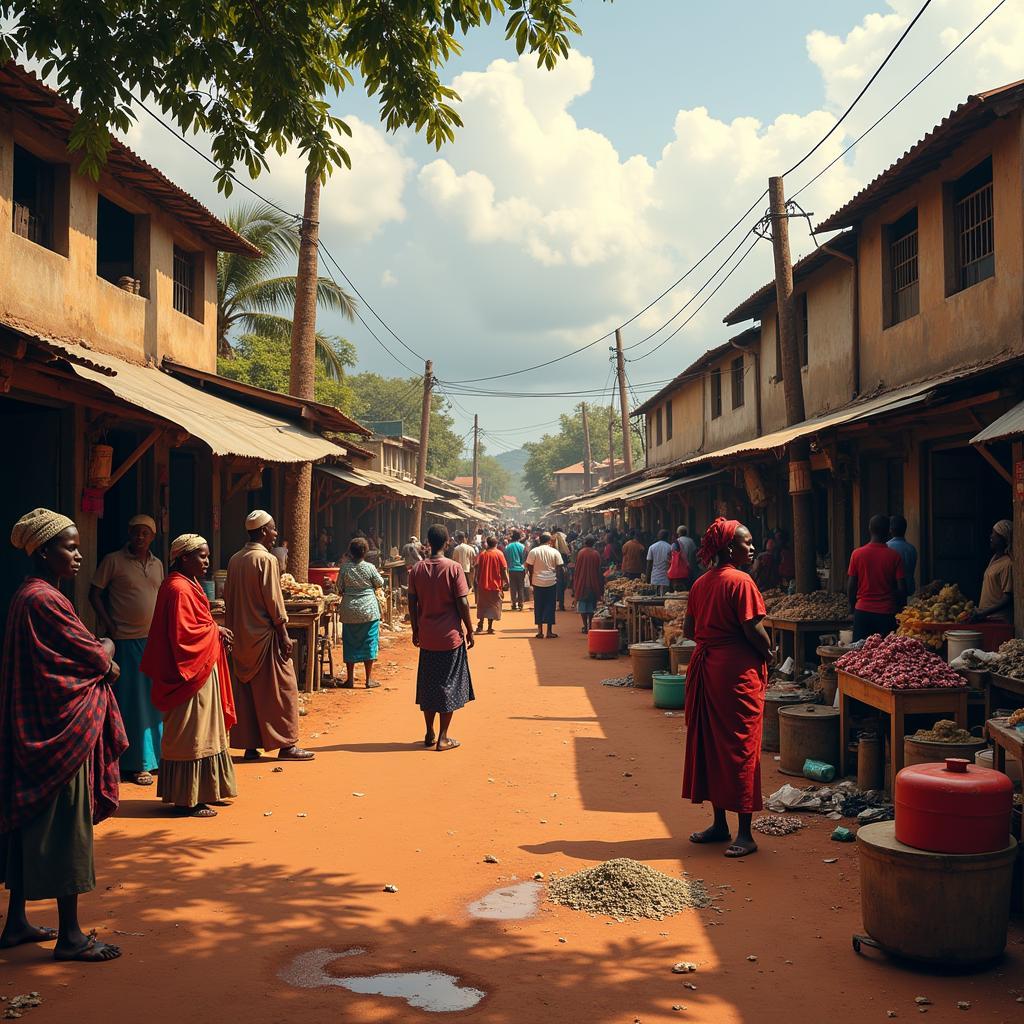The African Continent Split in Two: Exploring the Great Rift Valley
The African continent, a land of vibrant cultures, diverse landscapes, and rich history, is also home to one of the most dramatic geological features on Earth: the Great Rift Valley. This massive geological formation, stretching over 6,000 kilometers from the Middle East to Mozambique, has played a pivotal role in shaping the continent’s landscape, biodiversity, and human history. The Rift Valley is not just a physical divide; it’s a testament to the planet’s dynamic geological processes and a key element in understanding the continent’s past and present.
The Great Rift Valley: A Splitting Story
The Great Rift Valley is a product of plate tectonics, the slow but powerful movement of the Earth’s crust. The African continent is slowly being pulled apart along the Rift Valley, a process that has been ongoing for millions of years. As the tectonic plates separate, the Earth’s crust weakens and stretches, creating deep valleys, volcanic mountains, and active volcanoes.
The Rift Valley is not just one continuous fracture; it’s a system of interconnected rifts, with the eastern and western branches being the most prominent. The eastern branch, which runs through Ethiopia, Kenya, and Tanzania, is the most active part of the Rift Valley. This is where the continental plates are pulling apart most rapidly, creating the most dramatic landscapes.
The Formation of the Great Rift Valley
The formation of the Great Rift Valley is a complex geological process that began millions of years ago.
- Stage 1: Uplift and Stretching: The African plate began to stretch and thin due to the forces pulling it apart. This stretching caused the crust to buckle and uplift, forming a series of mountains and plateaus.
- Stage 2: Faulting and Rifting: As the stretching continued, the crust began to fracture along deep lines of weakness called faults. The movement along these faults created a series of rift valleys, separated by fault blocks that were uplifted.
- Stage 3: Volcanism and Erosion: The volcanic activity along the Rift Valley is caused by the upwelling of magma from the Earth’s mantle. This magma often erupts through the surface, creating volcanoes and building up new landforms. Erosion, caused by wind and water, has shaped the landscape of the Rift Valley over millions of years.
The Impact of the Rift Valley on Africa
The Great Rift Valley has had a profound impact on the African continent in various ways.
Impact on the Landscape
The Rift Valley is home to some of Africa’s most dramatic landscapes, including:
- Volcanic Mountains: The Rift Valley is home to some of Africa’s highest volcanic peaks, including Mount Kilimanjaro in Tanzania and Mount Kenya in Kenya. These mountains are popular tourist destinations, offering breathtaking views and challenging hiking opportunities.
- Deep Valleys: The Rift Valley is characterized by deep, steep-sided valleys, which have been carved out by erosion over millions of years. These valleys are home to a wide variety of ecosystems, from dry savannas to lush forests.
- Lakes and Rivers: The Rift Valley is home to a number of lakes, including Lake Victoria, the largest lake in Africa, and Lake Tanganyika, the second deepest lake in the world. These lakes are vital sources of water for the surrounding communities and are also important habitats for a wide variety of fish and wildlife.
- Hot Springs and Geysers: The volcanic activity along the Rift Valley has created a number of hot springs and geysers, which are often associated with geothermal energy. These features are a unique spectacle and offer opportunities for tourism and energy development.
Impact on Biodiversity
The diverse landscapes of the Rift Valley have led to the development of a rich and varied biodiversity.
- Unique Plant and Animal Species: The Rift Valley is home to a number of unique plant and animal species, including the endangered mountain gorilla, the African wild dog, and the Grevy’s zebra. These species have adapted to the unique conditions of the Rift Valley and are found nowhere else in the world.
- Endemic Species: Many species of plants and animals are endemic to the Rift Valley, meaning they are found only in this region. This is a testament to the importance of the Rift Valley as a center of biodiversity.
- Evolutionary Significance: The Rift Valley has been a major center of evolution for millions of years. The isolation of different populations within the valley has led to the development of new species, making it a crucial area for understanding the process of evolution.
Impact on Human History
The Rift Valley has also played a significant role in human history.
- Early Human Evolution: The Rift Valley is home to some of the most important fossil sites in the world. These sites have yielded evidence of early hominids, including Australopithecus afarensis, known as “Lucy,” and Homo habilis, both of which are considered to be key ancestors of modern humans.
- Migration Routes: The Rift Valley has been a major migration route for humans and other animals for millions of years. The movement of people and animals along the Rift Valley has led to the dispersal of cultures, languages, and genes across the continent.
- Settlements and Cultures: The Rift Valley has been a center of human settlement and culture for thousands of years. The fertile soils and abundance of water resources have made it a favorable area for agriculture and pastoralism. The diverse cultures of the Rift Valley have developed unique traditions, languages, and artistic expressions.
“The Rift Valley is more than just a geological feature; it’s a testament to the dynamic forces that have shaped our planet. It’s a place where we can witness the evolution of landscapes, the diversity of life, and the history of humankind,” shares Dr. John Akumu, a renowned geologist and expert on the Rift Valley.
The Future of the Rift Valley
The Great Rift Valley continues to evolve and change, driven by the forces of plate tectonics. In the future, the rift is expected to continue to widen, eventually leading to the separation of the African plate into two distinct continents. This process, which is expected to take millions of years, will create a new ocean basin in the East African region.
The Rift Valley presents both challenges and opportunities for the people and ecosystems within its influence.
Challenges:
- Seismic Activity: The movement along the faults in the Rift Valley can cause earthquakes and volcanic eruptions, posing risks to human settlements and infrastructure.
- Climate Change: Climate change is impacting the Rift Valley, leading to changes in rainfall patterns, increased droughts, and changes in vegetation. These changes can threaten the livelihoods of people and the ecosystems they depend upon.
- Population Growth: The Rift Valley is home to a rapidly growing population, putting pressure on natural resources and leading to deforestation, soil erosion, and conflict over land use.
Opportunities:
- Geothermal Energy: The volcanic activity along the Rift Valley provides a potential source of clean and sustainable energy. Geothermal power plants can be built to harness the heat from the Earth’s interior, reducing reliance on fossil fuels.
- Tourism: The Rift Valley offers a wide variety of tourism opportunities, from wildlife viewing to cultural experiences. This tourism can contribute to economic development and job creation in the region.
- Conservation: The Rift Valley is home to a unique and valuable biodiversity. Conservation efforts are essential to protect these ecosystems and the species they support.
Understanding the Rift Valley: A Journey Through Time
The Great Rift Valley is a natural marvel, a testament to the power of the Earth and the resilience of life. By exploring its geological formations, diverse ecosystems, and rich history, we gain a deeper understanding of the processes that shape our planet and the interconnectedness of all living things.
“The Rift Valley is a reminder of the grandeur and the fragility of our planet. It is a place where we can learn about the past, present, and future of life on Earth,” concludes Dr. Akumu.
FAQ
Q: How long has the Great Rift Valley been forming?
A: The formation of the Great Rift Valley began millions of years ago, and the process is still ongoing.
Q: What is the future of the Great Rift Valley?
A: The Rift Valley is expected to continue to widen, eventually leading to the separation of the African plate into two distinct continents.
Q: What are some of the challenges facing the Rift Valley?
A: Some challenges facing the Rift Valley include seismic activity, climate change, and population growth.
Q: What are some of the opportunities presented by the Rift Valley?
A: Some opportunities presented by the Rift Valley include geothermal energy, tourism, and conservation.
Q: Where can I learn more about the Great Rift Valley?
You can learn more about the Great Rift Valley by visiting the website of the African Wildlife Foundation, a large near african rift valley, or by visiting the african rift valley map.
 Map of the Great Rift Valley
Map of the Great Rift Valley
 Landscape of the Great Rift Valley
Landscape of the Great Rift Valley
 Wildlife in the Great Rift Valley
Wildlife in the Great Rift Valley
The Great Rift Valley is a complex and fascinating region, with a story that spans millions of years. Its geological processes, diverse ecosystems, and rich history make it a truly remarkable place. By learning more about the Rift Valley, we can better understand the forces that have shaped our planet and the challenges and opportunities that lie ahead for the African continent.



